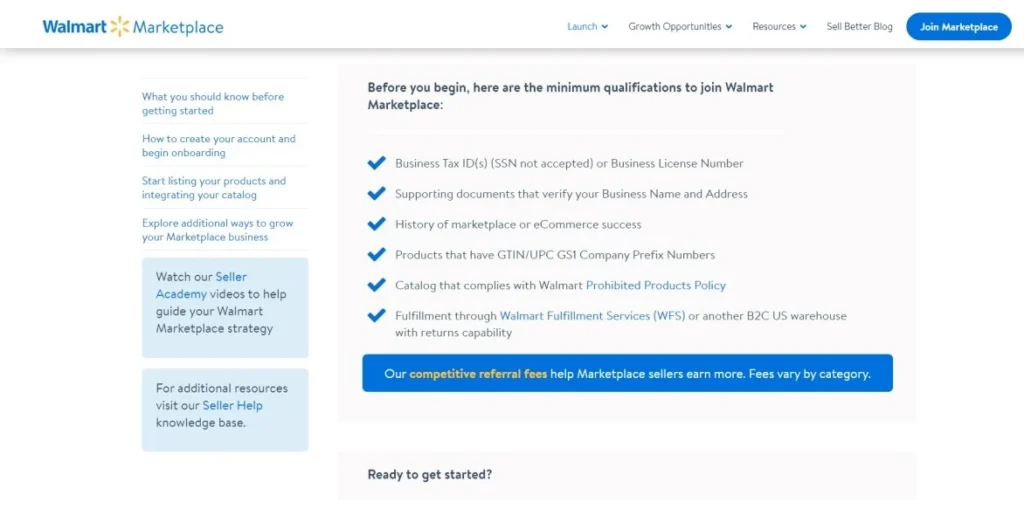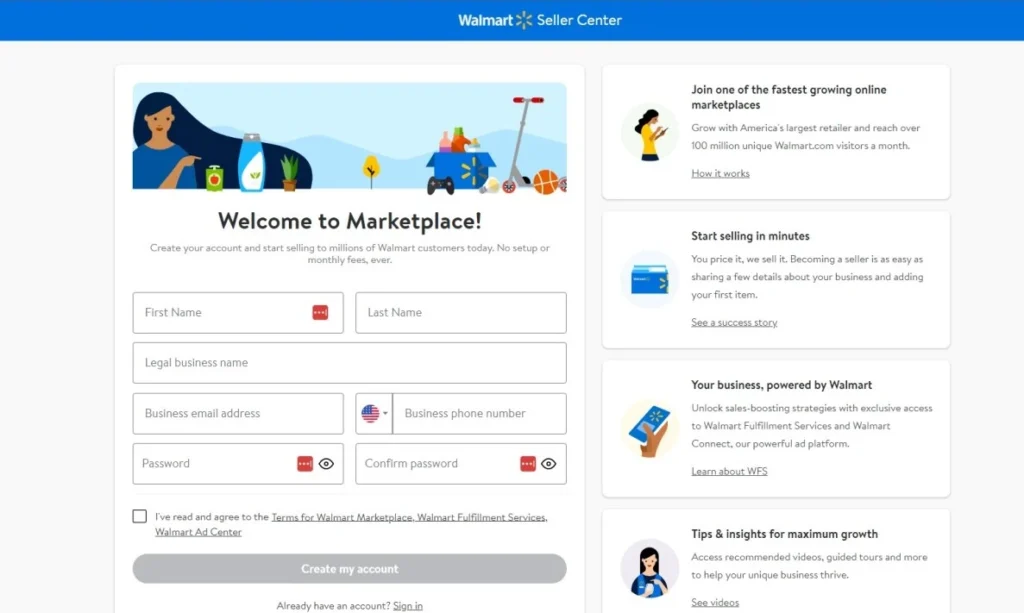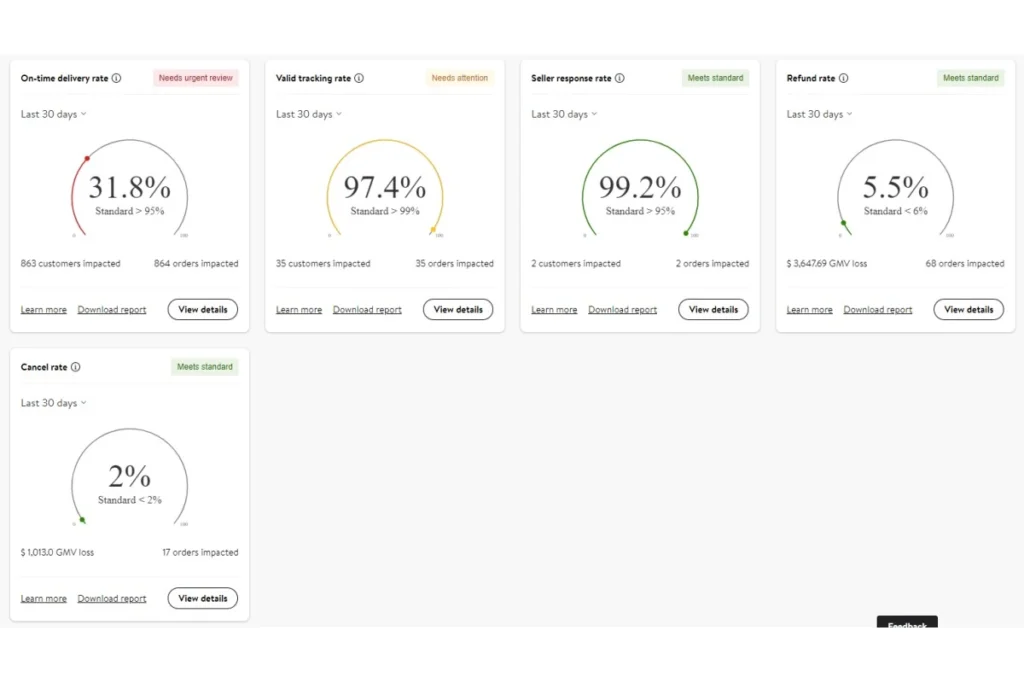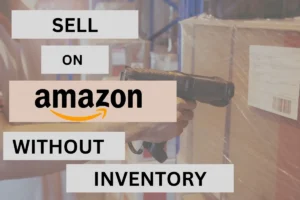Walmart Dropshipping is growing in popularity as a great way to make money online. With its low prices, wide selection, and easy-to-use platform, Walmart Dropshipping is a good choice for eCommerce sellers.
If you’re considering starting a dropshipping business, Walmart Dropshipping is one of the best options out there. With more than 100 million unique visitors each month, it’s easy to start selling online. But before you leap, there are a few things you should know about dropshipping from Walmart.
In this comprehensive guide to Walmart Dropshipping, we’ll walk you through the basics of dropshipping and its potential for entrepreneurs. We’ll also provide key tips and strategies to help you maximize profits and grow your business.
So if you’re looking to get started or want to take your existing business to the next level, read on! With the right approach and a little effort, Walmart Dropshipping is an easy way to make money from home.
What is Walmart Dropshipping?

Walmart dropshipping is a retail business model where a seller lists and sells products on Walmart.com without physically holding the inventory.
Usually, the seller purchases the products from a third-party supplier who directly ships the products to customers.
To earn a profit, the seller charges a higher price to the customer than what they pay the supplier. This model allows the seller to avoid the costs and risks associated with holding inventory, such as storage, packaging, and shipping.
The seller, or “dropshipper,” is responsible for managing an effective, compliant online storefront. This includes creating a Walmart seller account, partnering with a reliable supplier, and finding the right dropshipping products.
Once your storefront is set up, the seller can use Walmart’s eCommerce marketplace to list their products and start earning money.
Does Walmart Allow Dropshipping?
Yes, Walmart allows the dropshipping model. However, there are some specific requirements and guidelines that need to be followed in order to dropship on Walmart.
The first thing you need to know about dropshipping on Walmart is that there are different ways to do it. Each of these ways to dropship on Walmart have their specific requirements.
If you follow these requirements to the T, then you will have no problems dropshipping on Walmart.
Ways to Dropship on Walmart
The three ways to dropship on Walmart include:
1. Third-party Walmart Marketplace
This model of Walmart dropshipping is usually referred to as 3P Walmart selling. Here, you can become a third-party seller on Walmart’s marketplace and list your dropshipped products for sale.
When an order is placed, you can fulfill it by dropshipping the product directly to the customer from your supplier.
To get started with third-party Walmart Marketplace dropshipping, a seller must first apply and be approved as a Walmart online marketplace seller.
Once approved, they can connect with suppliers who offer dropshipping services and list their products on the Walmart eCommerce Marketplace.
The seller is responsible for managing their listings, customer service, and order management. The dropshipping supplier is responsible for fulfilling orders and shipping products directly to the customer.
2. Walmart Fulfillment Services (WFS)
Walmart Fulfillment Services (WFS) is a dropshipping method that allows Walmart Marketplace sellers to store their inventory in Walmart’s warehouses and have Walmart handle the fulfillment and shipping of customer orders.
Essentially, WFS allows sellers to use Walmart’s logistics and infrastructure to streamline their fulfillment process and provide faster and more reliable shipping to customers.
To participate in WFS, Walmart Marketplace sellers must meet certain requirements, including having a minimum of 10,000 SKUs, meeting performance standards, and paying a fulfillment fee for each item stored and shipped by Walmart.
Once approved for WFS, sellers can send their inventory to Walmart’s fulfillment centers and manage their listings and orders through the Walmart Seller Center.
3. Walmart Drop Ship Vendor (DSV) Program
The Walmart Drop Ship Vendor Program is a partnership between Walmart and select suppliers.
As a Walmart DSV, you do not have to hold any inventory, as the supplier will fulfill orders directly to your customers. This method requires sellers to have a direct partnership with the supplier and follow Walmart’s specific guidelines for the DSV program.
The supplier will handle the storage, packaging, and shipping of the products, while the seller handles the marketing, sales, and customer service aspects.
For example, the seller must have a direct relationship with the manufacturer or supplier of the products they are selling, and the supplier must be able to provide proof of authorization to sell the products.
Additionally, the seller is responsible for providing customer service and handling any returns or refunds in this dropshipping program. Walmart also has specific rules about pricing, shipping times, and product availability that must be followed by dropshippers.
Walmart Marketplace Seller Qualifications

To become a seller on Walmart Marketplace, there are several qualifications that you need to meet. These qualifications include:
- Business Registration: You must have a valid US business to sell on Walmart Marketplace. Note that Walmart does not accept social security numbers as a valid business registration number. They require your business tax ID and completed tax forms (W8 or W9 and EIN verification letter). To complete the onboarding process, you’ll have to submit your business address.
- Product Catalog Requirements: Your products must meet Walmart’s quality standards and guidelines provided in their prohibited product policy.
- Listings Requirements: Your product should have GTIN/UPC GS1 Company Prefix Numbers. Without these numbers, you cannot list items on the Walmart Marketplace. If you want to learn more about UPC codes and how you can find them, check out our article on Walmart UPC codes.
- Returns Capabilities: Walmart requires all sellers on their platforms – regardless of the selling or dropshipping method you take – to have the capacity to handle any returns or exchanges that may be necessary. Now returns can be tricky for Walmart sellers. You need to be armed with strategies to handle returns in such a way that will not affect your Walmart store’s rankings; strategies we provide in our guide to Walmart returns article.
The four qualifications listed above are a summary of the core requirements that must be met to be able to qualify as a seller on Walmart.
There are additional things you need to take note of as well to reduce your chances of getting flagged on Walmart. These include:
- Shipping and Delivery: You must be able to deliver your products on time and at a competitive price.
- Customer Service: You must have a good track record of providing excellent customer service.
- Performance Metrics: Your performance metrics, such as customer feedback and order defect rate, must meet Walmart’s standards.
- Fees and Charges: You must agree to pay Walmart’s fees and charges, which include a referral fee and a subscription fee.
Is Walmart Dropshipping Profitable?
Walmart dropshipping can be profitable for sellers who have a good understanding of the market, choose the right products, and employ effective marketing strategies. Here are some data-backed cogent points on why Walmart dropshipping is profitable:
1. Large Customer Base
Walmart has a massive customer base. With over 100 million unique visitors per month, the online store is one of the largest online retailers in the world. This presents a great opportunity for Walmart dropshippers to tap into this large customer base and make sales.
2. Low Competition
Compared to other saturated marketplaces like Amazon, eBay, and Shopify, Walmart’s marketplace has a relatively lower number of sellers. This means that there is less competition for sellers, making it easier to rank higher on Walmart’s search results and make more sales.
3. Low Fees
Walmart charges lower fees compared to other marketplaces. For example, Walmart’s referral fee ranges from 6% to 15%, while Amazon’s referral fee ranges from 6% to 45%, depending on the category. The lower fees mean that sellers can keep more profits from their online sales.
4. Brand Recognition
Walmart is a well-known brand with a trusted reputation. This gives customers confidence when buying from the Walmart marketplace, which can lead to more sales for Walmart dropshippers.
5. Fast Shipping
Walmart offers fast and reliable shipping options, including free two-day shipping and next-day delivery options. This means that customers can receive their orders quickly, which can lead to more positive reviews and repeat business.
6. Profit Margins
Walmart’s low prices and large inventory provide opportunities for sellers to find profitable products with high profit margins. Walmart’s low prices allow sellers to purchase items at a lower cost and sell them at a higher price, resulting in a higher profit margin.
Why You Should Consider Walmart Dropshipping
When it comes to selling on Walmart, this sales channel offers several advantages. From gaining access to Walmart’s massive customer base to leveraging Walmart’s trusted brand name, here are some of the benefits:
1. Growing Customer Base
Walmart is one of the largest online marketplaces, with a wide variety of customers and shoppers. Boasting over 100 million unique visitors per month, Walmart offers plenty of opportunities for growth and success.
2. No Hidden Fees
Unlike other platforms, Walmart doesn’t charge any setup, monthly, or subscription fees. The only fees you’ll be paying is just fulfillment fees and shipping costs. This is an excellent opportunity for new dropshippers, as there is no need to invest in costly resources.
3. Expedited Delivery Options
Walmart offers Free TwoDay and ThreeDay expedited delivery options. When you enable the program and include your items, Free TwoDay delivery tags will be added to your items. This lets you grasp the attention of even more customers and drive more sales.
In fact, Walmart sellers who use the Free TwoDay delivery options receive a 36 percent Buy Box lift compared to those who don’t. This can lead to an increase in sales and other opportunities to grow your online business.
Of course, like all other dropshipping options, Walmart also requires sellers to adhere to specific terms and conditions. Failure to do so will result in account suspension or termination. Thus, it’s essential to familiarize yourself with Walmart’s policies before getting started.
How to Dropship on Walmart: Four Key Steps to Success
Now that you’re familiar with Walmart and dropshipping let’s discuss how it works. Dropshipping on Walmart is a great way to build brand equity, increase sales, and earn more money—but how exactly do you get started?
To help you get up and running like a pro, here are four key steps to dropshipping success at Walmart:
1. Apply and Get Approved As a Seller at Walmart Marketplace

The first step to begin dropshipping with Walmart is to apply as a seller on Walmart Marketplace. To do so, you’ll need to provide your name, business name, email, and phone number.
You’ll also need to agree to the terms for Walmart Marketplace, Walmart Fulfillment Services or Walmart DSV depending on the dropshipping route you want to take, and Walmart Ad Center.
Once you have created your Walmart seller central account, Walmart will review your application and determine whether you are eligible to become a seller. It is important that you provide complete and accurate information when applying, as any inaccuracies or incomplete documentation can delay the approval process.
If your application is approved, you will receive an email from Walmart confirming your status as a seller and further instructions on getting started.
2. Activate Your Account and Get Onboarded
Once you receive confirmation of your status as a seller, the next step is to activate your account and complete the onboarding. This includes completing your registration, building your partner profile, and testing orders.
You will also be required to submit documents such as identity verification, tax information, and bank account details.
Once this process is complete, you will be allowed to list items on the site and start selling.
3. Search for Potential Suppliers and Products Online
The supplier, or vendor, is the foundation of your dropshipping business. To find the right supplier, you’ll need to do some research.
Begin by searching online for potential suppliers. You also may want to consider factors such as pricing, product selection, and shipping times.
Once you’ve settled on a reliable supplier, it’s important to establish and maintain communication with them regularly.
By building trust, you ensure timely deliveries, cost and quality control measures, product availability, and good customer service.
You can employ the help of the best Walmart seller tools to help you find potential products to sell online via product research. A Walmart product research tool will not only make your selection of products easier, but it can also potentially improve your revenue.
4. Start Fulfilling Orders and Making Money
Congratulations, it’s time to start selling! You can manage orders and transactions through your account, including tracking sales and payment status for each order.
Additionally, you will also be able to use various features such as shipping options and product management tools.
Sellers are responsible for monitoring orders with defects, shipping orders on time, and shipping orders with valid tracking numbers. In the event that your order defect rate (ODR) exceeds Walmart’s standards, you may be suspended.
You may also be suspended if you fail to respond to the Partner Performance Team. To avoid this, refer to Seller Performance Standards to understand how Walmart’s metrics are calculated.
How To Optimize Your Product Listing on Walmart?
So, you’ve created your Walmart Marketplace store – now what?
You must optimize your product listings to get the most out of your marketplace experience. Listings optimization, for example, can help you win the Walmart buy box. This can help you reach the right shoppers and get more sales.
To help you get started, here are six tips for optimizing your product listings:
1. Use Stunning and Optimized Product Images
Product images are essential for any product listing. They give shoppers an idea of what the product looks like and how it can be used.
Make sure all your images are clear and high-resolution. Failure to capture a shopper’s attention with quality imagery can lead to fewer clicks and sales.
2. Create Captivating Product Titles and Product Descriptions
Product titles and descriptions are your chance to showcase what the product is, the features, and benefits your product will offer to potential customers. Take the time to create compelling copy that speaks to your audience and highlights why they should buy your product.
It’s also important to ensure that your product descriptions are clear and concise.
Finally, avoid using too much jargon, and don’t forget to provide shoppers with all the information they need.
3. Price Reasonably, but Not So Cheaply That You Lose Profit
Pricing your product correctly is an essential part of selling online. Keeping your price competitive will help you attract customers.
However, make sure you generate a sufficient profit from each sale to cover your expenses. With the right price, you can attract more customers and increase sales.
One way to keep your pricing competitive is to utilize repricer strategies. These strategies take advantage of Walmart repricing tools, like the Ecom Circles Walmart repricer, to help you stay ahead of your competition in terms of pricing.
4. Ensure Excellent Customer Service To Encourage Positive Reviews
Providing excellent customer service can help you win the loyalty of your customers and keep them coming back for more.
To ensure that you provide the best customer service, offer timely responses to inquiries, helpful advice, and troubleshooting tips.
You can also ensure that your supplier delivers orders on time and that you process returns promptly. Positive customer reviews can help your dropshipping business to stand out from competitors, make sure you nurture your customers.
5. Automate Your Product Listing
Product listing automation can save you a lot of time and energy when managing your online store.
Using automated listing tools, you can quickly list products, update prices and descriptions, and keep your store up-to-date. This reduces the manual effort required to manage an eCommerce store and eliminates costly errors.
6. Sync Your Inventory With Listings
Out-of-date inventory makes for an unpleasant customer experience. Keep your product listings up-to-date with your actual inventory levels to give your customers accurate information.
This saves shoppers from being frustrated when an item goes out of stock and eliminates the chance of overselling.
Check out our Walmart product listings optimization article to learn more about the topic.
How Does Walmart Marketplace Track Your Seller Metrics?

To avoid suspending sellers due to lack of performance, Walmart has implemented a range of seller-tracking metrics. These allow you to monitor your success rate in real-time and make necessary changes.
The Seller Center dashboard oversees the performance of your products and provides recommendations for improvement.
To ensure ongoing performance, keep an eye on the following seller metrics:
Order Defect Rate (ODR)
Order defect rate or ODR is a percentage of orders not fulfilled correctly within the agreed timeframe. This could include incorrect items, missed shipping timelines, or poor packaging. The Walmart Marketplace ODR should be below 2%.
Failure to comply with Walmart’s ODR standards will result in the suspension or removal of your products from the platform.
On-Time Shipment Rate
On-time shipment rate or OTSR is a measure of the percentage of orders which are shipped on time. Walmart requires all merchants to ship at least 97% of their orders on time.
Any shipments that do not meet Walmart’s standards will be penalized. If vendors fail to maintain an OTSR of 97% or higher, their products may be suspended or removed from the platform.
To ensure compliance with Walmart’s OTSR requirements, strive to exceed the 97% threshold by working closely with your supplier.
Valid Tracking Rate
Hitting the valid tracking rate or VTR benchmark is essential for Walmart merchants. The goal is to ensure that all orders are tracked accurately and delivered within the expected timeframe.
Vendors must maintain a VTR of 80% or higher across all orders or risk being penalized by Walmart. Keep your VTR above 80% to stay compliant by monitoring orders, reviewing delivery times, and providing accurate tracking information.
It is also vital that you avoid using fake tracking numbers, as this will cause your VTR to fall.
How to Monitor your own Performance in Walmart Seller Center?

While Walmart may conduct periodic reviews, you should also monitor your own performance in the Seller Center.
The Seller Center provides several reports regarding orders that did not meet fulfillment expectations. This includes order status, delivery times, and customer service ratings associated with each seller.
To view insights into your performance, sign in to Seller Center and navigate to Analytics > Performance. Once there, choose the tab that offers the details you’re looking for.
Seller Scorecard
Using the Seller Scorecard tab, you can view your ODR and download reports for each type of order defect. Here you can also find your On-Time Shipment Rate and customer reviews.
Fulfillment
You can see your shipping metrics on the fulfillment tab and view reports on unfulfilled orders.
By better analyzing your performance data, you’ll have a clearer view of buyers’ perceptions and areas that need improvement. Use these insights to take direct action toward reaching your dropshipping business goals.
With the help of the Performance area in Seller Center, you can continuously monitor and improve customer satisfaction.
Important FAQs About Walmart Dropshipping
Now that you know the basics of the Walmart dropshipping business model, you’re ready to get started!
Before you jump in, however, let’s take a look at some common questions that come up when considering Walmart dropshipping:






